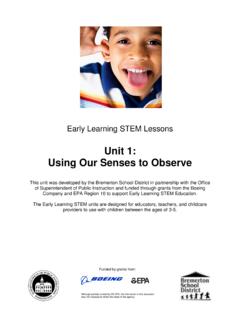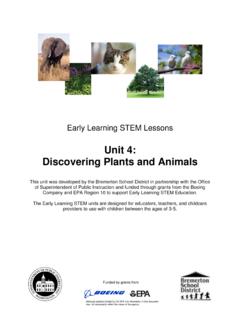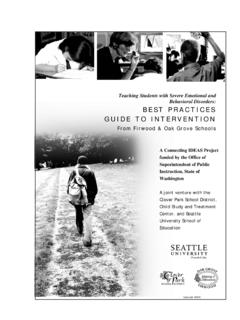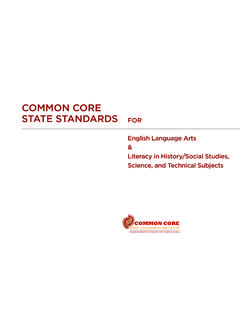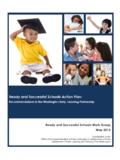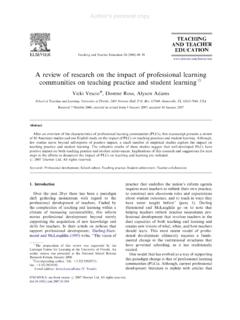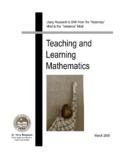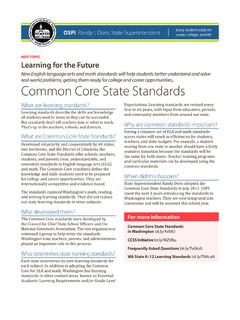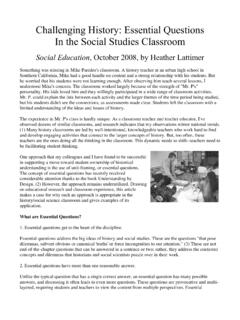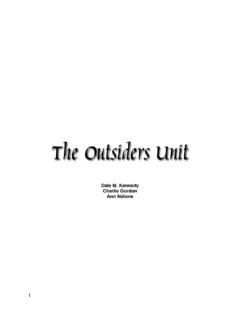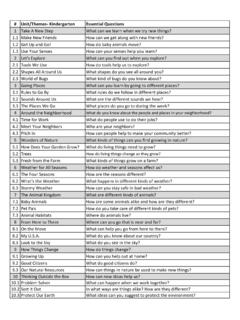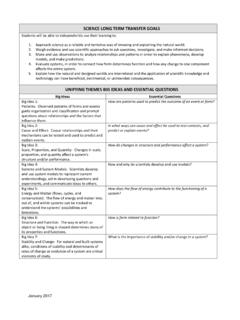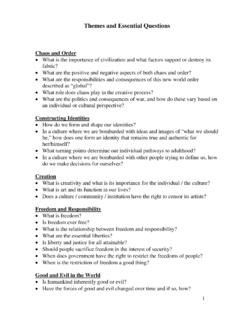Transcription of NINTH-TENTH GRADES – SUGGESTED UNIT …
1 SUGGESTED unit OUTLINES FOR SOCIAL STUDIES GLES 9th-10th GRADES NINTH-TENTH GRADES SUGGESTED unit OUTLINES In ninth and tenth grade , students apply their deeper understanding of social studies concepts on a global scale. The recommended context in the ninth and tenth grade is modern world history, 1450 to the present. Students explore major themes and developments that shaped the modern world, including human rights, revolution and democracy, to develop an understanding of the roots of current world issues. The following pages provide unit outlines to help you organize a modern world history course around the required state standards. As with the other grade levels, these SUGGESTED unit outlines are framed along two dimensions: chronological era and major developments or themes . Civics, economics, geography, and social studies skills are embedded in this framework. They start with possible essential and guiding questions to help frame the unit .
2 The sample guiding questions focus on the specific issues that connect with the particular era, developments, or themes . The sample essential questions are meant to remind us of how the themes and eras addressed in a particular unit relate to timeless important issues and concepts. Please note that while the GLEs (in bold) are required, the examples are merely suggestions. Since it would be impossible to address all of the important cultures, peoples, and nations throughout the world over nearly six hundred years of history, these examples are meant to provide some possible contexts in which to teach these standards. They are not meant to be followed like a recipe or as a one-size-fits-all curriculum. Ultimately, it is up to teachers and administrators in each district to decide how to tailor this course and these examples to their students and community s particular interests and needs. They will have to help decide which themes and developments in world history students will examine deeply and which they will look at as points of comparison.
3 By balancing depth and breadth, students will have the opportunity to gain enduring understandings that world history teaches us about ourselves and our world. To help develop these enduring understandings, these unit outlines include recommended placement of several of the state s Classroom-Based Assessment models (CBAs). To see the full requirements of the CBAs referenced below, visit OSPI s social studies assessment web page. unit Outlines for NINTH-TENTH GRADES : Overview 1. World- Global Expansion and Encounter (1450-1750) 2. World- Age of Revolutions (1750-1914) 3. World- International Conflicts (1870-Present) 4. World- Emergence and Development of New Nations (1900-Present) 5. World- Challenges to Democracy and Human Rights (1945-Present) CBAs: Humans and the Environment, Causes of Conflict, Technology Through the Ages, Overview Required GLE SUGGESTED Examples HISTORY Understands how the following themes and developments help to define eras in world history: Global expansion and encounter (1450 1750).
4 Age of revolutions (1750 1917). International conflicts (1870 present). Emergence and development of new nations (1900 present). Challenges to democracy and human rights (1945 present). Explains how the Atlantic slave system helps to define world history from 1450 to 1750 as an age of expansion and imperialism. Explains how the French, Industrial, and Russian Revolutions help to define world history from 1750 to 1917 as an age of revolutions. Explains how the causes and consequences of World War I and World War II define 1870 to the present as a time of international conflict. Explains how nationalism in Asia and Africa helps to define the 20th century as an era of new nations. Explains how the experience of South African apartheid helps to define world history as an era of challenges to human rights. SUGGESTED unit OUTLINES FOR SOCIAL STUDIES GLES 9th-10th GRADES unit outline 1: World- Global Expansion and Encounter (1450-1750) essential question (s): How are societies transformed in an era of global trade?
5 What are the political, economic, geographic, and social implications of cultural expansion? Guiding question (s): What impact did European domination have on various regions and the world? How did trade accelerate global political and economic expansion from 1450 to 1750? Required GLE SUGGESTED Examples HISTORY , Part 1 Understands how the following themes and developments help to define eras in world history: Global expansion and encounter (1450 1750). Explains how the Atlantic slave system helps to define world history from 1450 to 1750 as an age of expansion and imperialism. Analyzes change and continuity within a historical time period. Examines how Spain under Ferdinand and Isabella changed with the influx of trade while still preserving the monarchy. Examines how the impact of guns caused some countries to form and others to maintain their power. GEOGRAPHY Identifies major world regions and understands their cultural roots.
6 Describes Latin America based on its colonial history. Understands the causes and effects of voluntary and involuntary migration in the world in the past or present. Explains the factors leading to the slave trade and its effects on societies in Africa and the Americas. Understands how the geography of expansion and encounter has shaped global politics and economics in the past or present. Explains how political boundaries drawn by colonial powers continue to serve as sources of conflict. Explains how the natural resources of North, Central, and South America affected the colonial aims of the British and Spanish. Compares how places with similar geographic characteristics, such as Mozambique and South Africa, have been differently influenced by colonial powers. SUGGESTED unit OUTLINES FOR SOCIAL STUDIES GLES 9th-10th GRADES unit outline 2: Age of Revolutions (1750-1917) essential question (s): What are the causes and consequences of political revolutions?
7 What are the economic, technological, political, social, and geographic causes of change in human societies? How are societies altered by the change from a rural/agrarian to an urban/industrial society? What are the effects of new political and economic ideas? Guiding question (s): What were the causes and consequences of the agricultural and industrial revolutions (1700 1890)? What were the causes and consequences of the French and Russian Revolutions? Required GLE SUGGESTED Examples HISTORY , Part 2 Understands how the following themes and developments help to define eras in world history: Age of revolutions (1750 1917). Explains how the French, Industrial, and Russian Revolutions help to define world history from 1750 to 1917 as an age of revolutions. Analyzes how individuals and movements have shaped world history (1450 present). Examines the impact Toussaint L Ouverture had on revolutionary ideas in Latin America.
8 Examines the impact Lenin had on revolutionary ideas in Russia. Analyzes how cultures and cultural groups have shaped world history (1450-present). Examines the impact the British Raj had on the reshaping of Indian society. ECONOMICS Analyzes how the costs and benefits of economic choices have shaped events in the world in the past or present. Examines how the French bourgeoisie s commercial success contributed to the beginning of the French Revolution. Examines how latifundistas decisions to expand their plantations contributed to the desire in Latin America for independence from Spain. CBA: Technology Through the Ages Required GLE SUGGESTED Examples HISTORY Analyzes and evaluates how technology and ideas have shaped world history (1450 present). Analyzes the costs, benefits, and long-term consequences of Adam Smith s ideas in the Wealth of Nations. SOCIAL STUDIES SKILLS Evaluates multiple reasons or factors to develop a position paper or presentation.
9 Evaluates multiple factors to determine the costs, benefits, and long-term consequences of Adam Smith s ideas in the Wealth of Nations. Creates strategies to avoid plagiarism and respects intellectual property when developing a paper or presentation. Demonstrates a note-taking strategy to keep track of one s own ideas and the ideas of others when conducting research. SUGGESTED unit OUTLINES FOR SOCIAL STUDIES GLES 9th-10th GRADES unit outline 3: World-International Conflicts (1870-Present) essential question (s): What economic, political, social, and geographic factors lead nations to fight with each other? What factors lead to peace between nations? What are the economic and political implications and outcomes of war? What is the role of international agreements and organizations in international relationships? What causes peoples to resort to genocide? Guiding question (s): What were the causes and consequences of World War I and II?
10 Required GLE SUGGESTED Examples HISTORY , Part 3 Understands how the following themes and developments help to define eras in world history: International conflicts (1870 present). Explains how the causes and consequences of World War I and World War II define 1870 to the present as a time of international conflict. CBA: Causes of Conflict Required GLE SUGGESTED Examples HISTORY Analyzes the multiple causal factors of conflicts in world history (1450 present). Examines the causes of World War I from political, economic, military, social, and religious perspectives to develop a position on the primary cause of the war. Examines Palestinians and Israelis perspectives on the causes of conflict in the Middle East to develop a position on the primary cause of the conflict. Analyzes and interprets historical materials from a variety of perspectives in world history (1450 present). Distinguishes between conflicting views of the causes of the Holocaust.
